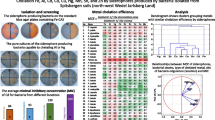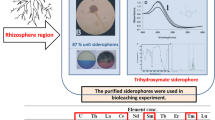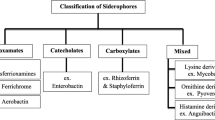Abstract
Siderophores are small molecular weight extracellular organic compounds secreted by microorganisms under iron-starved conditions, used by them to chelate and solubilize iron. Though they are specific ferric iron chelator, but is reported that they bind other metals also, such as divalent heavy metals and actinides because of potentially high metal-siderophore stability constants. Thus metal contaminant fate and transport in subsurface environment can be heavily influenced by siderophores. This approach can be successfully used in removing many toxic metals off the soil which poses a serious health threat. Our research focuses on the correlation between cell growth and siderophore production and chemical characterization of the siderophore type. Its also documents the development of an assay method for the screening of different metals for complexation with siderophores based on the Chrome Azurol S (CAS) assay. The present research aims at batch scale mobilization of arsenic from arsenic contaminated soils using siderophore produced by P. azotoformans and thus evaluating its efficiency as compared to Ethylene Diamine Tetra Acetic Acid (EDTA), Citric Acid (CA) for the same. FT-IR spectroscopic studies were carried out to determine the interaction between soil, arsenic and siderophore. Results have shown that the cell growth and siderophore production are inversely related. Characterization of siderophore produced by P. azotoformans has revealed that it is of mixed-type catecholate and hydroxamate. Siderophore was found to complex with heavy metals like Cadmium, Lead, Nickel, Arsenic (III, V), Aluminium, Magnesium Zinc, Copper, Cobalt, Strontium other than Iron. Five washings by siderophore, EDTA, CA removed almost 92.8%, 77.3%, 70.0% arsenic respectively as compared to only 33.8% removal by control. Washing of arsenic contaminated soil with tap water revealed that ≈ 65.8% of arsenic in contaminated soil is in freely available or weakly bound form. The IR spectra revealed that hydrogen bonding exists between siderophore, arsenic and soil. Encouraging results of arsenic removal by biomolecule-siderophore can lead to an emerging tool brimming with opportunities for environmental clean up.





Similar content being viewed by others
References
Abumaizar, R. J., & Smith, E. H. (1999). Heavy metal contaminants removal by soil washing. Journal of Hazardous Materials, 70(1–2), 71–86.
Adriano, D. C. (1986). Trace elements in the terrestrial environmental: Biogeochemistry, bioavailability, and risks of metals (pp. 47–72). Berlin Heidelberg New York: Springer.
Aiken, A. M., Petersen, J. M., Peyton, B. M., Apel, W. A., & Camper, A. K. (2003, Winter). Siderophore mediated metal transport in subsurface environments. Poster abstract W03-P302, CBE Technical Advisory Conference, Bozeman, MT.
Arnow, L. E. (1937). Colorimetric determination of the components of 3, 4-dihydroxyphenylalanine-tyrosine mixtures. Journal of Biological Chemistry, 118, 531–537.
ATSDR (2005a). Comprehensive Environmental Response, Compensation, And Liability Act (Cercla). Atlanta: ATSDR.
ATSDR (2005b). Toxicological profile for arsenic. Department of Health and Human Services, Atlanta, GA. Retrieved from http://www.atsdr.cdc.gov/toxiprofile/tp2-c2.
Black, C. A., Evans, D. D., White, J. L., Ensminger, L. E., & Clark, F. E. (1965). Methods of soil analysis: Chemical and microbiological properties. Agronomy monogram no. 9, Pt. 2. Madison, WI: ASA.
Branson, J. M., & Patrick, W. J. (1987). Fixation, transformation and mobilization of arsenic in sediments. Environmental Science and Technology, 20, 450–459.
Bultreys, A., Gheysen, I., Maraite, I., & Hoffmann, E. (2001). Characterization of fluorescent and non fluorescent peptide siderophores produced by Pseudomonas syringae strains and their potential use in strain identification. Applied and Environmental Microbiology, 67(4), 1718–1727.
Carrano, C. J., Jordan, M., Drechsel, H., Schmid, D. G., & Winkelmann, G. (2001). Heterobactins: A new class of siderophores from Rhodococcus erythropolis IGTS8 containing both hydroxamate and catecholate donor groups. Biometals, 14, 119–125.
Casida, L. E. (1965). Abundant microorganisms in soil. Applied Microbiology, 13(3), 327–334.
Clark, B. L. (2004). Characterization of a catechol-type siderophore and the detection of a possible outer membrane receptor protein from Rhizobium leguminosarum strain IARI 312. Dissertation, East Tennessee State University, Johnson City, TN.
Csaky, T. Z. (1948). On the estimation of bound hydroxylamine in biological materials. Acta Chemica Scandinavica, 2, 450–454.
Durbin, P. W., Jeung, N., Rodgers, S. J., Turowski, P. N., Weitl, F. L., White, D. L., & Raymond, K. N. (1989). Removal of 238Pu (IV) from mice by poly-catecholate, -hydroxamate or -hydroxypyridonate ligands. Radiation Protection Dosimetry, 26, 351–358.
Freibach, H. S., Hadar, Y., & Chen, Y. (2004). Interaction of iron chelating agents with clay minerals. Soil Science Society of America, 68, 470–480.
Frost, R. L., Martens, W., Williams, P. A., & Kloprogge, J. K. (2003). Raman spectroscopic study of the vivianite arsenate minerals. Journal of Raman Spectroscopy, 34, 751–759.
Gaitatzis, N., Kunze, B., & Muller, R. (2005). Novel insights into siderophore formation in myxobacteria. ChemBioChem, 6(2), 365–374.
Goldberg, S., & Glaubig, R. A. (1988). Anionsorption on a calcareous montmorrillonite soil—arsenic. Soil Science Society Of American Journal, 52, 1297–1300.
Govil, P. K., & Reddy, G. L. L. (2004). Report on: Inventorisation of contaminated sites in India.
Hider, R. (1984). Siderophore mediated absorption of iron. Structure & Bonding, 58, 25–87.
Jadhav, R. S., & Desia, A. J. (1992). Isolation and characterization of siderophore from coepea Rhizobium (peanut isolate). Current Microbiology, 24(3), 137–141.
Kayser, A., & Neubauer, U. (2005). Biological decontamination of heavy metal polluted soils using hyperaccumulator plants: Influencing the uptake of heavy metals in the root zone. Research project of Soil Protection Group, Swiss Federal Institute of Technology, Zurich.
Rozman, K. K., Klaassen, C. D., & Watkins, J. B. III. (2003). Absorption, distribution, and excretion of toxicants. In C. D. Klaassen & J. B. Watkins III (Eds.) Essentials of toxicology (Vol. 30). New York: McGraw-Hill.
Leong, S. A., & Winkelmann, G. (1998). Molecular biology of iron transport in fungi. Metal Ions in Biological Systems, 35, 147–186.
Lindsay, W. L., & Norvell, W. A. (1978). Development of a DTPA soil test for zinc, iron, manganese and copper. Soil Science Society of American Journal, 42, 421–428.
Lombi, E., Sletten, R. S., & Wenzel, W. W. (2000). Arsenic sequentially extracted in sand, silt and clay of contaminated soils. Water, Air, and Soil Pollution, 124(3–4), 319–332.
Lowry, O. H., Rosebrough, N. J., Farr, A. L., & Randall, R. J. (1951). Hartree, -Lowry and modified Lowry protein assays. Journal of Biological Chemistry, 193, 265–275.
Macrellis, H. M., Trick, C. G., Rue, E. L., Smith, G., & Bruland, K. W. (2001). Collection and detection of natural iron-binding ligands from seawater. Marine Chemistry, 76(3), 175–187.
Malik, A. (2004). Metal bioremediation through growing cells. Environmental International, 30(2), 261–278.
Maria, E. D., & Pillar, V. (2002). Evaluation of the siderophore production by Pseudomonas aeruginosa PSS. Revista Latinoamericana de Microbiologia, 44 (3–4), 112–117.
Mustafa, G., Singh, B., & Kookana, R. S. (2004). Cadmium desorption from goethite in the presence of desferrioxamine B and oxalic acid. Oral paper presented at 3rd Australian New Zealand Soils Conference: Super Soil 2004, Sydney, Australia.
Neilands, J. B. (1983). Siderophores. In L. Eichhorn & L. G. Marzilla (Eds.), Advances in inorganic biochemistry (Vol. 5, pp. 137–166). Amsterdam: Elsevier/North Holland.
Neubauer, U., Furrer, G., Kayser, A., & Schulin, R. (2000). Siderophore, NTA, and citrate: Potential soil amendments to enhance heavy metal mobility in phytoremediation. International Journal of Phytoremediation, 2(4), 353–368.
O’Neill, P. (1995). Arsenic. In B. J. Alloway (Eds.), Heavy metals in soils, 2nd edn. (pp. 105–121). London: Blackie.
Bricker, O. P., Paces, T., Johnson, C. E., & Sverdrup, H. (1994). Weathering and erosion aspects of small catchments research in biogeochemistry of small catchments. In B. Moldan (Ed.), Biogeochemistry of small catchments—A tool for environmental research (pp. 87–88). Chichester: Wiley.
Page, A. L., Miller, R. H., & Keeney, D. R. (Eds.) (1982). Methods of soil analysis: Chemical and microbiological properties, 2nd edn. Agronomy monogram no. 9, Pt. 2. Madison WI: Soil Science Society of America.
Peters, R. W. (1999). Chelant extraction of heavy metals from contaminated soils. Journal of Hazardous Materials, 66, 151–210.
Peters, G. R., McCurdy, R. F., & Hindmarsh, J. T. (1996). Environmental aspects of arsenic toxicity. Critical Review in Clinical Laboratory Science, 33, 457–493.
Peyton, B., & Apel, W. A. (2005). Siderophore influence on the mobility of both radionuclides and heavy metals. INRA Informer, 5(2), 2–4.
Pons, A., Roca, P., Aguilo, C., Garcia, F. J., Alemany, M., & Palou, A. (1981). A method for the simultaneous determination of total carbohydrate and glycerol in biological samples with the anthrone reagent. Journal Biochemical Biophysical Methods, 4(3–4), 227–231.
Raksasataya, M., Langdon, A. G., & Kim, N. D. (1996). Assessment of the extent of lead redistribution during sequential extraction by two different methods. Analytical Chimica Acta, 332, 1–14.
Ratledge, C. (2004). Iron, mycobacteria and tuberculosis. Tuberculosis (Edinburgh), 84, 110–130.
Raymond, K. N., Muller, G., & Matzanke, B. F. (1984). Complexation of iron by siderophore: A review of their solution and structural chemistry and biological function. In F. L. Boschke (Ed.), Topics in current chemistry (pp. 49–102). Berlin Heidelberg New York: Springer.
Renshaw, J. C., Halliday, V., Robson, G. D., Trinci, A. P., Weibe, M. G., Livens, F. R., et al. (2003). Development and application of an assay for uranyl complexation by fungal metabolites, including siderophores. Applied and Environmental Microbiology, 69(6), 3600–3606.
Schwyn, B., & Neilands, J. B. (1987). Universal chemical assay for the detection and determination of siderophores. Analytical Biochemistry, 160, 47–56.
Sun, X., & Doner, H. E. (1996). An investigation of arsenate and arsenite bonding structures on goethite by FTIR. Soil Science, 161(12), 865–872.
USEPA (1992). Test methods for evaluating solid waste, physical/chemical methods, 3rd edn. (Vol. 1) EPA Publication SW-846. Washington, DC: Office of Solid Waste and Emergency Response, USEPA.
USEPA (1997). Technology alternatives for remediation of soils contaminated with arsenic, cadmium, chromium, mercury, and lead. Engineering Bulletin, EPA/540/s-97/500.
Vala, A. K., Dave, V., & Dube, H. C. (2006). Chemical characterization and quantification of siderophores produced by marine and terrestrial Aspergilli. Canadian Journal of Microbiology, 52(6), 603–607.
Valersi, T. (1998). Kinetics and bonding structures of arsenic sorption in soils and model substances. Ph.D. thesis, University of Agricultural Sciences, Vienna, Austria.
Walsh, L. M., & Keeney, D. R. (1975). Behaviour and phytotoxicity of inorganic arsenicals in soils. In E. A. Woolson (Ed.), Arsenical pesticides. American Chemical Society Symposium Series 7, 35–52.
Wasay, S. A., Barrington, S. F., & Tokunaga, S. (1998). Remediation of soils polluted by heavy metal using salts of organic acids and chelating agents. Environmental Technology, 19, 369–379.
Woolson, E. A., Axley, J. H., & Kearney, P. C. (1971). The chemistry and phytotoxicity of arsenic in soil. 1. Contaminated field soils. Soil Science Society of American Proceedings, 35, 938–943.
Yang, G. Z. (1983). Clustre analysis of some elements in soils of Tainijin area. Acta Science Circumstantiae, 3, 207–212.
Yarnell, A., & Washington, E. N. (2003). Nature’s tiniest geoengineers. Science and Technology, 81(42), 24–25.
Acknowledgments
The authors acknowledge Dr. Sukumar Devotta, Director, NEERI, Nagpur for encouragement and valuable suggestions. We specially thank Dr. Srimant Kagne and Mr Ravi Chatti for interpretation of FT-IR results. Thanks go to Ms Prachi Joshi and Ms Radha for their suggestions and constant support. The authors are thankful to the reviewers for their constructive comments.
Author information
Authors and Affiliations
Corresponding author
Rights and permissions
About this article
Cite this article
Nair, A., Juwarkar, A.A. & Singh, S.K. Production and Characterization of Siderophores and its Application in Arsenic Removal from Contaminated Soil. Water Air Soil Pollut 180, 199–212 (2007). https://doi.org/10.1007/s11270-006-9263-2
Received:
Accepted:
Published:
Issue Date:
DOI: https://doi.org/10.1007/s11270-006-9263-2




